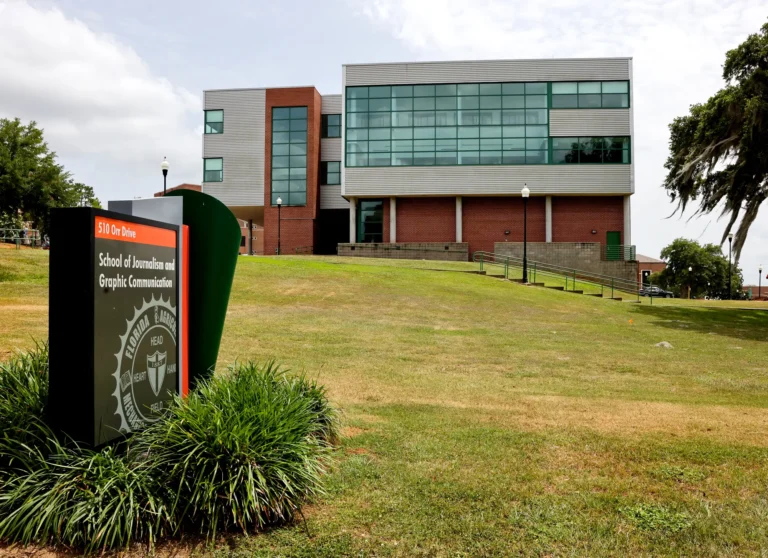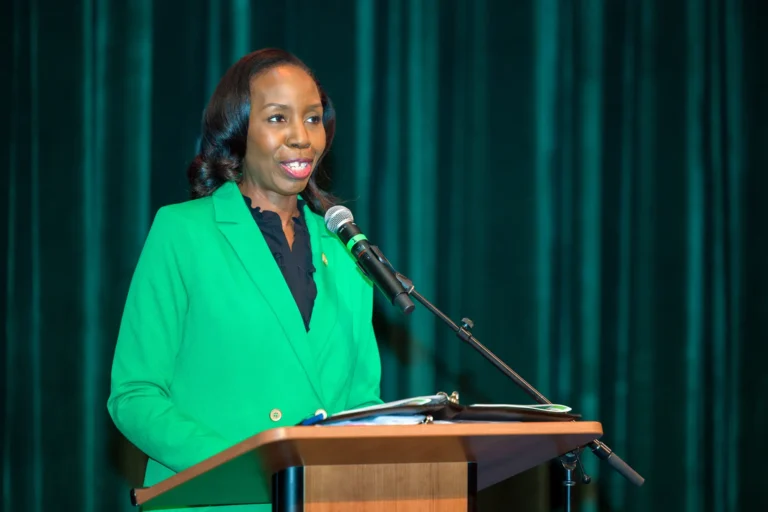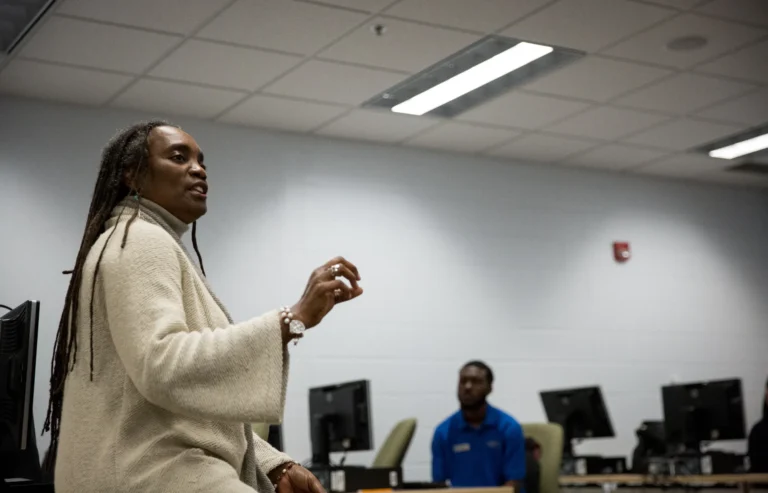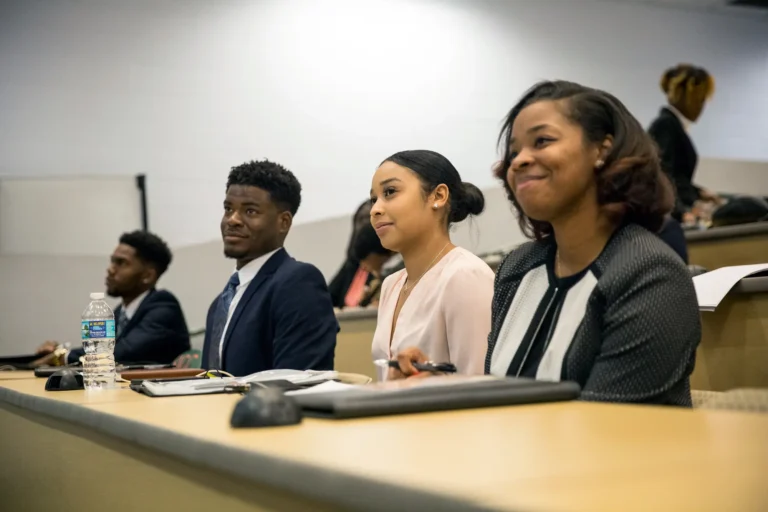
Executive Summary
The School of Journalism & Graphic Communication (SJGC) has adequate resources to fulfill and sustain its mission despite the changing dynamics and scope of higher education in Florida. As a member of the State University System of Florida, the University receives appropriations from the legislature typically allocated to the President, Chief Financial Officer, and the Office of the Provost. Those primary units then provide different allocations to the individual colleges and schools. Much of the school’s budget is dedicated to administrative and faculty salaries, day-to-day operations, and technological resources. Facilities are maintained by the University, which allows the programs to use their allotted funding toward resources that will promote student learning, faculty development and scholarship.
SJGC is a 100,000-square-foot facility that is home to four multimedia properties: TV 20, WANM 90.5, The FAMUAN, and Journey magazine. These platforms provide students with practical, hands-on experience in the profession. The building houses 15 computer labs and 10 studios, offering ample space for students to hone their skills. Experiential learning is a cornerstone of the SJGC experience, with courses and labs like the PR Agency, Capital Bureau, Advanced TV News, Reporting & Writing III, Visual Storytelling and Documentary & Film.
The school offers various resources, including a Writing Lab, Office of Student Success and Office of Career Success, all geared toward student support. Additionally, the SJGC Print Shop caters to the printing needs of both the school and the University, ensuring high-quality production for various projects.
- Complete Table 10, “Budget.” If necessary, provide a supplementary explanation.
Table 10. Budget
Show below the annual unit budget for each of the three years preceding the accreditation visit. “Annual budget” refers to funds directly under control of the unit for the entire year (12 months). Budget figures should not include expenditures for building maintenance, retirement allowances, scholarships, prizes, or student aid. List student newspaper budget only if it is under control of unit and is used in instruction.
| Budget Items | 2021-2022 | 2022-2023 | 2023-2024 (Self-study year) |
|---|---|---|---|
| Administrative salaries | $338,681.71 | $392,290.00 | $400,090.00 |
| Teaching salaries (full time) | $921,697.00 | $1,196,503.00 | $1,217,346.00 |
| Teaching salaries (part time/adjunct) | $95,727.00 | $125,318.68 | $133,784.00 |
| Teaching assistants | n/a | n/a | n/a |
| Clerical salaries | $82,820.00 | $172,000.00 | $181,500.00 |
| Equipment | $166,781.73 | $166,423.76 | $318,547.93 |
| Equipment maintenance | $27,767.79 | $38,073.83 | $33,838.55 |
| Supplies | $11,345.05 | $3,469.95 | $3,812.64 |
| Library resources | $40,000 | $40,000 | $40,000 |
| Databases, online information services | $59,066.72 | $64,474.22 | $65,787.94 |
| Travel* | n/a | n/a | n/a |
| Research* | n/a | n/a | n/a |
| Other (please list) | n/a | n/a | n/a |
| Total Annual Journalism/PR Budget | $1,743,887.00 | $2,198,553.44 | $2,394,707.06 |
- Describe the process through which the unit develops its budget, including preparation of the budget request and spending plan, review and approval, and the role of faculty in the process.
The Board of Governors for the State University System (SUS) (BOG) allocates SUS appropriations to each respective university. The President approves guidelines for the distribution of the allocation. The Chief Financial Officer (CFO), with the assistance of the Budget Office, distributes operating resources to each Division including the Division of Academic Affairs. In consultation with Deans and Department Heads, the Provost and each Vice President distributes resources to Schools, Colleges, and departments in accordance with the President’s guidelines. FAMU’s annual budget is approximately $12.5M allocated by the State of Florida. Approximately 75-80% are provided to the academic units for personnel and salary.
To build the budget and facilitate spending requests from the faculty, the unit developed a budget process that requires faculty to send their requests to their Division Director. The Director, along with the auxiliaries, media outlets, and SJGC IT, submit their budget for the next fiscal year to the dean for consideration in February. The dean creates the unit budget using the aforementioned information and submits it to the Division of Academic Affairs, overseen by the Provost’s office.
To effectively manage the unit’s fiscal and administrative affairs, the unit hired an associate dean in 2024 to oversee all fiscal management of the school, with the dean’s approval. The associate dean (Dr. Elaine Bryant) is responsible for day-to-day financial operations and administrative activities to ensure resources are appropriately allocated and aligned with the School and the University’s strategic plans and goals.
Link for SJGC Budget Process
- Describe the adequacy of resources for the unit and the sources of revenue for those resources (university funds, fees, private funding, other). Describe how the unit will supplement its annual budget from other sources or reallocate resources to reach its strategic goals.
The School of Journalism & Graphic Communication primarily relies on the University’s Education & General (E&G) Funds, allocated annually, for its daily operations, faculty and staff salaries, technological resources, library resources, and general maintenance. For needs beyond the budget, special requests can be made to the Division of Academic Affairs, typically for equipment upgrades and services.
In addition to E&G Funds, the school actively seeks new funding through special allocations and grants. Successful funding sources include:
- Title III funding of $775,000 (2023-2024) for technological innovation
- A multi-year $1,000,000 grant from the Walt Disney Company (2022-2023) to establish the Disney Storytellers Fund at FAMU, providing tuition and housing scholarships, stipends, and professional development to students
- A $175,000 grant from the NBCU Academy (2021-2022) for student and course support
The school also garners support from entities like the Winning Foundation, Dow Jones News Fund, Florida Society of News Editors (FSNE), iHeartRadio, Knight Foundation, MacArthur Foundation, Luce Foundation, and alumni.
Student support comes from various scholarships, including the Journalism Scholarship Endowment, Faculty and Staff Scholarship Endowment, Kim Godwin Scholarship, Ben Crump Ida B. Wells Scholarship, James E. Hawkins Endowed Scholarship, Ricardo M. Lewis Scholarship, and FINN-FCF Scholarship.
SJGC operates within the University’s centralized advancement model, working with a development team that sets giving priorities and solicits gifts. The unit collaborates with University personnel on key initiatives, like the FAMU 1887 Strikes: Day of Giving Campaign, which raised more than $23,000 for SJGC in April 2024.
The University provides Performance Based Funding (PBF) to colleges and schools for specific student success initiatives or operational needs. In 2022-2023, the unit received $85,000 to create the SJGC Writing Lab, equip the Capital Bureau and establish a space for the PR Agency. In 2023-2024, the unit received $115,000 for operations.
SJGC has two endowed chairs, the Knight Chair and the Garth C. Reeves Eminent Scholar, which recognize professional excellence and creative activities. The endowment funds supplement the positions and bolster initiatives of the school.
- Describe how the resources provided by the institution compare with the resources for similar units on your campus.
The School of Journalism & Graphic Communication is one of the 14 colleges and schools within the University, consistently ranking in the top 5 for enrollment, making up 6-7% of the University’s total student body. The largest college on campus is the College of Social Sciences, Arts and Humanities, followed by the School of Allied Health Sciences, the College of Science and Technology, and the School of Business and Industry.
SJGC receives funding from the Division of Academic Affairs for faculty salaries, other personnel services (e.g., adjunct faculty, consultants), expenses (e.g., supplies and travel), and operating capital outlay (e.g., equipment and computers). These are the funds that are awarded and expended yearly. The budget for SJGC for the most recent year was $3,518,427 and is comparable to that of similar schools within the University: School of Architecture and Engineering Technology (SAET) and the School of the Environment (SOE). SAET has a total of four undergraduate programs and one graduate program for which three of them are accredited. The School of the Environment has two undergraduate programs and two graduate programs. SJGC has a total of three undergraduate programs. The table below shows the budget for all three schools.
| Year | SJGC | Architecture | Environment |
|---|---|---|---|
| 2017-2018 | $2,475,206 | $3,353,044 | $1,856,028 |
| 2018-2019 | $2,682,331 | $3,527,361 | $1,869,081 |
| 2019-2020 | $3,006,936 | $3,749,328 | $2,025,588 |
| 2020-2021 | $3,167,289 | $3,951,312 | $2,338,428 |
| 2021-2022 | $2,876,708 | $3,702,453 | $1,785,778 |
| 2022-2023 | $2,944,461 | $3,737,667 | $1,817,539 |
| 2023-2024 | $3,616,434 | $3,908,531 | $1,972,764 |
| 2024-2025 | $3,518,427 | $3,639,435 | $2,447,848 |
SJGC, like many technology-driven units on campus, necessitates constant upgrades, but at an even more accelerated pace due to the rapidly evolving media landscape. Equipment can become obsolete within two to three years, requiring timely updates for computer hardware, software, video cameras, audio equipment, and other technologies to align with those used in commercial media markets, ensuring students are well-prepared for their careers. Additionally, it is essential to have faculty and technical staff who are well-versed in emerging technologies, often necessitating further professional development workshops and conferences.
In 2021, SJGC’s Computer Applications Coordinator facilitated a partnership with Adobe on behalf of the School of Journalism & Graphic Communication, making FAMU the second HBCU Creative Campus. This designation grants every student on campus free access to all Adobe products.
Given the school’s prominent campus presence, its facility frequently serves the wider university community. The main lecture hall, equipped with smart technology and more than 100 seats, along with the adjacent multipurpose gallery, are often used by other units and public groups for events. The TV and radio studios and podcast rooms are also utilized by University leadership, Academic Affairs, Athletics, and guests.
In 2023, the Department of Social Work temporarily relocated to SJGC due to the demolition and reconstruction of their building. In 2024, the University’s Emergency Management team also moved into the building. Honoring its values of collaboration and professionalism, SJGC strives to be a supportive academic partner to its colleagues and community.
- Describe the unit’s classrooms, offices, computer labs or other building spaces as well as technology support services. If the unit administers university media or student publications, include a description of equipment and facilities devoted to those operations.
Facilities
The unit has numerous classrooms, offices, and computer labs, creating a conducive environment for teaching and learning. Equipped with state-of-the-art resources to support the curriculum, the school features 15 computer labs (12 full-size and 3 mini-labs) with a total of 320 workstations (both PC and MAC), 16 edit bays, 2 television studios and control rooms, and a variety of equipment such as video and still cameras, tripods, and microphones available for checkout.
These production facilities are open for student use 11 hours daily, with additional hours as needed. Additionally, the SJGC Library computer lab offers 24 more computers with all the necessary instructional software.
The transition to virtual learning during the COVID-19 pandemic in 2020 revealed that some students lacked access to essential software like Adobe Creative Cloud and adequate home computers for remote instruction and assignments. In response, the University allocated approximately $1 million from CARES Act funding to SJGC to provide Adobe Creative Cloud licenses to all faculty, staff, and students, offer Virtual Desktop Interface (VDI) services for remote ENPS hosting, and purchase 30 Apple MacBook Pro laptops for students and 15 for faculty. Additionally, the funding included 100 Final Cut Pro licenses, mobile device management software, and other resources. Currently laptops can be checked out by students on an as-needed basis. Additional laptops can be obtained at the main University Coleman Library.
The 100,000-square-foot facility is under 24-hour surveillance and recently upgraded its building access and security system to include HD surveillance and over 30 dual proximity card readers, monitored by FAMU’s Department of Campus Safety & Security.
SJGC Library
In the 2023-2024 academic year, the SJGC Resources Center served 4,610 students with study and group spaces and 1,390 service transactions.
The resources for this unit are adequate and generally exceed expectations for supporting the academic programs within the SJGC. There is one full-time librarian and two part-time assistants to operate the library and serve the students and faculty. The librarian provides liaison services to the faculty, which include teaching information literacy classes at the request of faculty, providing research consultations to students and faculty, and receiving recommendations for additional resources. Reference services are provided in person, by phone, and by an online chat service known as Ask-A-Librarian.
The SJGC branch library is open Monday – Thursday, 9 a.m. to 8 p.m., and Friday, 9 a.m. to 5 p.m. The branch location is closed on Saturdays and Sundays. Students also have access to the main library location, Coleman Library, which is open seven days a week during the fall and spring semester.
The funding for library personnel, operations, and information resources is provided by the University’s education and general budget allocation.
Within the SJGC Library, there are seven PC stations provided by the University Libraries and a Mac lab with 24 computers provided by the SJGC. These computers have graphics and production software installed that students use in their classes. This computer lab is operated and maintained by SJGC staff. The library also provides a scanner and printing station.
Link for SJGC Resource Center
TV 20
TV-20 is an educational access cable channel that reaches 80,000 households in four North Florida counties, including Leon, Gadsden, Taylor, and Wakulla. It operates 24 hours a day and in addition to live student newscasts, the channel broadcasts many university events including commencement, convocation, concerts, and guest speakers. All shows air on Comcast Cable Channel 20.
TV 20 has a full-time station director (Edward Thomas) and an assistant director (Spencer Henderson). Funding for the station’s day-to-day operation is provided by the academic unit. The station also generates revenue via production projects around campus.
With the support of university and Title III funding, the academic unit has made significant upgrades to TV 20’s main Studio A since 2022, bringing the studio and control room in line with industry standards. The newest equipment include Hitachi HD/4K Studio Configured Camera Systems, Vinten Vision 250 Pro Pedestal Studio Tripod Pedestals, Cue Script 19” Studio Teleprompter Monitors and Controller, AJA 4K Digital Audio/Video Recorder, Multi-Screen Monitors, Studio Lighting and Cabling. This investment allows students to get hands-on experience with equipment used by media companies; deliver high-quality programming for airing and streaming to local and remote audiences; and produce high-resolution content for their reels.
In 2022, FAMU TV-20 also added video streaming capacity via the web. This enhancement allows alumni, prospective students, parents, and funders the opportunity to view original university and student programming.
To help expand students’ capabilities to report live from the field, the studio acquired LiveU units in Spring 2024, enabling real-time visual transmission from anywhere with Internet or cellular connectivity.
WANM-FM 90.5
WANM-FM Radio, also known as “The Flava Station,” has a full-time station director (Terrence Ward) and a team of students who program, operate and manage the day-to-day operations. The station is a non-commercial radio station licensed to the Florida A&M University Board of Trustees. The student-run campus station broadcasts with 1600 watts and operates 24 hours a day, 365 days per year. Its format includes Gospel, Jazz, Blues, Soul, R&B, Hip-Hop and Reggae. In addition to music, WANM produces news- and sports casts, current events/pop culture talk shows, sports shows and coverage of FAMU campus events.
In the 2023-2024 academic year, the WANM-FM radio station also benefited from Title III funds allowing for the purchase of broadcast consoles and software in three control rooms. The operational needs of the station are covered by the academic unit and by special requests to SGA (Student Government Association).
Convergence Newsroom
The Convergence Newsroom hosts The FAMUAN and Journey Magazine, situated next to WANM-FM. TV 20 broadcast students use this space for training and assignments. It is a collaborative environment where students from different disciplines collaborate on projects. The newsroom often serves as a press room for Q&As with newsmakers and guest speakers, and is used by faculty, staff, and students involved in student media for meetings and activities.
The newsroom features four Apple iMac computers with Adobe Creative Cloud software, Apple Final Cut Pro, and CNN Newsource, plus eight HP computers with AP ENPS. Next to the newsroom is a lab with 25 HP computers equipped with AP ENPS, a smart podium, a projection screen, and a Zoom cart with a 4K sensor camera for virtual guests, presentations, video conferencing, and streaming content. There is also a dedicated radio area with two HP computers equipped with AP ENPS, two audio booths with Adobe Audition, audio interfaces, studio microphones, and studio monitors. Journey Magazine’s office includes four Apple iMacs with Adobe Creative Cloud software, all purchased within the last two years.
The FAMUAN is equipped with 17 new Apple iMacs, loaded with Adobe Creative Cloud, Microsoft Office 365, Final Cut Pro, and other essential software for creative and desktop publishing tasks. Student photographers use two Canon mirrorless cameras to cover news and sports events.
In Fall 2024, The FAMUAN joined the HBCU Digital Media Collaborative, an organization that supports HBCU campus newsrooms with technological innovation and hands-on assistance for news publishing and product development. Working with students, faculty and staff, the Collaborative transitioned The FAMUAN’s website from Uloop to an advanced content management system (CMS) and robust hosting infrastructure, ensuring long-term newsroom sustainability.
The new website features a dynamic homepage, newsletter subscription capture, embeddable multimedia assets, and browser push notifications. It also provides revenue-generating opportunities through direct-sold and remnant advertising, and donation capabilities.
Editorial efficiencies include the seamless transfer of text from Google Docs to WordPress. The FAMUAN is also leveraging AI to optimize headlines for SEO and engagement.
Equipment
The MAC workstations are equipped with software listed below:
- Adobe Creative Cloud Photoshop, Illustrator, InDesign, Muse, XD, Dreamweaver, Premiere, Audition, Acrobat Pro and After Effects
- Apple Final Cut Pro, Motion, Compressor
- AVID Protools
- Microsoft Office Word, Excel, and PowerPoint
The PC workstations are equipped with the software listed below:
- IBM SPSS
- Sony Vegas
- Microsoft Office Word, Excel, and PowerPoint
- Associated Press ENPS and ENPS Mobile App
- ENCO Digital Audio Delivery
Computer Labs
| Room | Type | Software |
|---|---|---|
| 2016 | PC | Microsoft Office Suite |
| 2037 | Mac | Microsoft Office Suite, Apple Final Cut Pro, Motion, Compressor, Adobe Creative Cloud Photoshop, Illustrator, InDesign, Muse, XD, Dreamweaver, Premiere, Audition, Acrobat Pro and After Effects |
| 2068 | Mac | Microsoft Office Suite, Adobe Creative Cloud Photoshop, Illustrator, InDesign, Muse, XD, Dreamweaver, Premiere, Audition, Acrobat Pro and After Effects |
| 2071 | Mac | Microsoft Office Suite, Adobe Creative Cloud Photoshop, Illustrator, InDesign, Muse, XD, Dreamweaver, Premiere, Audition, Acrobat Pro and After Effects |
| 2072 | Mac | Microsoft Office Suite, Software for visually impaired |
| 2076 | PC | Microsoft Office Suite |
| 3052 | PC | Microsoft Office Suite, Adobe Creative Cloud Photoshop, Illustrator, InDesign, Muse, XD, Dreamweaver, Premiere, Audition, Acrobat Pro and After Effects |
| 3127 | Mac | Microsoft Office Suite, Adobe Creative Cloud Photoshop, Illustrator, InDesign, Muse, XD, Dreamweaver, Premiere, Audition, Acrobat Pro and After Effects |
| 3132 | Mac | Microsoft Office Suite, Adobe Creative Cloud Photoshop, Illustrator, InDesign, Muse, XD, Dreamweaver, Premiere, Audition, Acrobat Pro and After Effects |
| 3133 | Mac | Microsoft Office Suite, Adobe Creative Cloud Photoshop, Illustrator, InDesign, Muse, XD, Dreamweaver, Premiere, Audition, Acrobat Pro and After Effects |
Radio Station
| Room | Type | Software and Equipment |
|---|---|---|
| Control Room #1 | Mac PC | Adobe Creative Cloud, Microsoft Office Suite, Zoom ENCO DAD Radio Automation Wheatstone Broadcast Console |
| Control Room #2 | Mac PC | Adobe Creative Cloud, Microsoft Office Suite, Zoom ENCO DAD Radio Automation Wheatstone Broadcast Console |
| Control Room #3 | Mac PC | Adobe Creative Cloud, Microsoft Office Suite, Zoom ENCO DAD Radio Automation Wheatstone Broadcast Console |
| Remote Equipment | Comrex Access NX | |
| Zoom Handheld Recorders | ||
| Rode i-XLR microphone adapter | ||
| Sony A73 video/still camera | ||
| EV microphones | ||
| Sennheiser microphone packs | ||
| Sennheiser EWG4 packet | ||
| Transmitters | Stream Guys streaming and podcast publishing service |
TV Station
| Room | Quantity | Equipment |
|---|---|---|
| Studio/Control Room | 1 | Hanabi 4K digital Video Switcher |
| 1 | Insight Digital Server | |
| 4 | Samsung 60” Multi-Screen Monitors | |
| 3 | Hitachi HD/4K Studio Configured Camera Systems | |
| 3 | Vinten Vision 250 Pro Studio Tripod Pedestals | |
| 3 | Cue Script 19” Studio Teleprompter Monitors and Controller | |
| 1 | KXWell PZT Camera Controller | |
| 1 | AJA 4K Digital Audio/Video Recorder (to record high resolution student Newscast reels) | |
| 1 | 65” Studio Monitor (Sports Wall) | |
| Equipment Checkout Room | 11 | Sony 4K NXcam Camcorders (Documentary and Film) |
| 20 | Sony HD XDcam Camcorders (TV News and Advanced TV News) | |
| 31 | Manfrotto Tripods | |
| 10 | Canon R EOS RP DSLR Camera Packages w/Rode wireless mics, Sennheiser headphones and tripod | |
| 4 | Canon XA55 4K Camcorder package w/carrying case | |
| 4 | Manfrotto Tripods | |
| 4 | Rode Bayonet camera mics | |
| 2 | Sony UWP D26 wireless mics | |
| 2 | Sony UWP D21 wireless mics | |
| 4 | Sennheiser Headphones | |
| 4 | Camera Lights | |
| 4 | ZOOM H6 Portable 6 track recorder | |
| 1 | Canon R EOS RP DSLR Camera w/backpack | |
| 1 | Canon R EOS RP DSLR Camera Package w/ Rode wireless mic, Sennheiser headphones and tripod | |
| 1 | Sony Alpha 6600 DSLR Camera Package w/wireless mics | |
| 1 | Rode On-camera mic | |
| 1 | Sennheiser Headphone |
- Describe the unit’s most urgent needs for resources, if any, and the plan to address these needs.
The unit is seeking additional resources and funding for the following initiatives and will work with university advancement, the budget office, other campus partners and alumni to identify funding sources for these needs, in addition to seeking external grants and donors to support the program.
Career Readiness
SJGC seeks to strengthen the Office of Career Success (OCS) and career readiness efforts. Areas of focus: Building database capacity to better track job placements, career progression and opportunities of students and alumni; expanding professional development programming; more funding for students to attend internships and professional conferences; and establishing the internship coordinator as a permanent position with additional personnel support for the OCS.
Academic Excellence
The school wants to establish new professorships for digital media/emerging technology, media & social justice, and sports to advance instruction, research, and curriculum. New lines would support the school’s vision to be globally recognized as a premier journalism and mass communication program, and FAMU’s strategic priorities and goals of academic excellence, leveraging the brand/reputation, and becoming a Carnegie R1 institution.
Technology and Innovation
Upgrade TV Studio B to expand the video production and original programming capacity of students and increase the production quality of video content. The studio, which is currently outfitted with standard definition equipment, is often utilized for university productions and the Athletic Department’s coach’s shows. The space needs new cameras, prompters, lighting, a switcher, an audio mixer, and cabling.
While the unit has made strides in installing smart technology in instructional spaces since the last revisit, the new curriculum and increase in virtual meetings are requiring the need for additional distant learning and engagement equipment. Currently 30% of the classrooms are without smart technology. We are seeking to equip four rooms with Crestron projectors, projection screens, ceiling speakers, document cameras, AirMedia and Lecture Capture in the next fiscal year.
Student Success
Expand the footprint of the Capital Bureau with an offsite location where students can work in the field and more closely with professional colleagues. The unit is exploring options near the Capital for reporting and filing of stories. This will better prepare students to deliver content while on-location, rather than from the studio or school, will enhance their job readiness and marketability.








